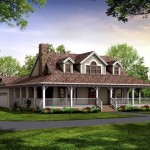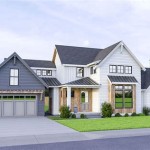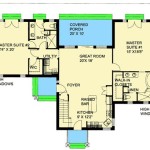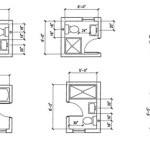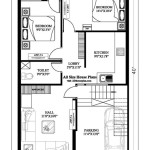Small Cottage Plans Under 1000 Sq Ft: A Comprehensive Overview
The appeal of small cottage living continues to grow, driven by factors such as affordability, sustainability, and a desire for a simpler lifestyle. Small cottage plans under 1000 square feet offer a practical solution for individuals, couples, or small families seeking a comfortable and efficient living space. These plans necessitate careful consideration of design principles to maximize available space while maintaining functionality and aesthetic appeal.
This article will delve into the various aspects of small cottage plans under 1000 square feet, exploring key considerations in design, material selection, and construction. It will also examine the advantages and limitations of this type of dwelling, along with practical tips for optimizing space and creating a welcoming environment.
Efficient Space Planning
Space planning is paramount when designing cottages under 1000 square feet. The goal is to create a layout that feels spacious and functional despite the limited square footage. This requires strategic thinking to incorporate multi-functional areas and eliminate unnecessary partitions. Open-concept designs, where the living room, dining area, and kitchen seamlessly flow into one another, are commonly employed to create a sense of spaciousness. The strategic placement of windows and doors is also essential to maximize natural light and ventilation, further enhancing the perceived size of the interior.
Within a small cottage plan, every square foot must serve a purpose. Hallways, often a significant consumer of space in larger homes, are typically minimized or eliminated altogether. Circulation paths should be carefully considered to ensure ease of movement without wasting valuable floor space. Pocket doors or sliding doors can be used in place of traditional swing doors to save space and improve traffic flow. Careful consideration should also be given to the placement of furniture and appliances. Built-in storage solutions, such as shelving units and window seats with storage underneath, can help to maximize vertical space and reduce clutter.
The vertical dimension is often underutilized in smaller homes. Utilizing the height of the ceilings can create a more spacious feeling. Lofts can be incorporated to provide additional sleeping spaces, home office areas, or storage. High shelves and cabinets can extend to the ceiling, providing ample storage without consuming valuable floor space. The effective use of vertical space is crucial for maximizing functionality and creating a comfortable living environment within a limited footprint.
Material Selection and Cost Considerations
The choice of building materials significantly impacts the overall cost, durability, and aesthetic appeal of a small cottage. Selecting cost-effective and sustainable materials is essential for staying within budget and minimizing environmental impact. Durable and low-maintenance materials can reduce the need for repairs and replacements in the long run, contributing to long-term cost savings.
Wood is a popular choice for cottage construction due to its affordability, availability, and natural aesthetic. However, the type of wood and its treatment can affect its durability and resistance to pests and rot. Engineered wood products, such as plywood and oriented strand board (OSB), offer a cost-effective alternative to solid wood, while also providing greater dimensional stability. Durable siding materials, such as fiber cement or vinyl, can protect the exterior of the cottage from the elements and reduce maintenance requirements.
Interior finishes also play a significant role in the overall cost and aesthetic of the cottage. Opting for budget-friendly flooring options, such as laminate or vinyl plank, can significantly reduce construction costs. Painting walls in light, neutral colors can create a brighter and more spacious feel. Utilizing reclaimed materials, such as salvaged wood or vintage fixtures, can add character and charm to the cottage while also reducing waste and costs. Careful planning and material selection are fundamental to building a small cottage that is both affordable and aesthetically pleasing.
Optimizing Natural Light and Ventilation
Natural light and ventilation are crucial for creating a comfortable and healthy living environment in a small cottage. Maximizing daylight penetration can reduce reliance on artificial lighting, saving energy and creating a brighter, more inviting space. Proper ventilation can improve indoor air quality, reduce the risk of mold and mildew growth, and regulate temperature.
The placement and size of windows are critical factors in optimizing natural light. Large windows, particularly those facing south, can capture ample sunlight. Skylights can provide additional daylight to areas of the cottage that may not have access to windows. Proper window placement should also consider privacy and solar heat gain. Overhangs or awnings can be used to shade windows during the hottest times of the day, reducing the need for air conditioning.
Natural ventilation can be achieved through the strategic placement of windows and doors to create cross-breezes. Operable windows, such as casement or awning windows, allow for better airflow than fixed windows. A whole-house fan can also be used to exhaust hot air from the cottage and draw in cooler air from outside. Proper insulation and sealing are essential for preventing air leaks and ensuring that the cottage remains comfortable year-round. Incorporating these elements helps create a healthy and energy-efficient living space.
Storage is a critical aspect of small cottage living. Maximizing storage solutions ensures a clutter-free and organized environment. Built-in storage, such as shelving units, drawers, and cabinets, can provide ample space for storing belongings without taking up valuable floor space. Vertical storage solutions, such as high shelves and wall-mounted organizers, can utilize the height of the ceilings to maximize storage capacity. Multifunctional furniture, such as storage ottomans or sofa beds with built-in storage, can also help to reduce clutter and maximize space.
The exterior design of a small cottage is as important as the interior layout. The exterior should be aesthetically pleasing and blend seamlessly with the surrounding environment. Simple, clean lines and natural materials can create a charming and inviting exterior. A well-designed porch or deck can provide additional outdoor living space and enhance the overall appeal of the cottage. Landscaping can also play a role in enhancing the exterior appearance of the cottage and creating a welcoming atmosphere.
The legal and regulatory aspects of building a small cottage should be thoroughly investigated before starting construction. Building codes and zoning regulations may impose restrictions on the size, location, and design of small dwellings. It is essential to obtain all necessary permits and approvals before beginning construction. Consulting with a local building inspector or architect can help to ensure that the cottage complies with all applicable regulations.
When reviewing small cottage plans, prospective builders should carefully examine the structural integrity of the design. Ensure that the plans meet local building codes for wind and seismic loads. Consider the foundation type and its suitability for the soil conditions at the building site. Verify that the roofing system is designed to withstand local weather conditions, including snow load and rainfall. A structurally sound design is essential for ensuring the long-term durability and safety of the cottage.
The selection of appliances and fixtures should also be carefully considered to maximize space and energy efficiency. Compact appliances, such as smaller refrigerators, stoves, and dishwashers, can save space in the kitchen. Energy-efficient appliances can reduce energy consumption and lower utility bills. Low-flow toilets and showerheads can conserve water and reduce water bills. Choosing appliances and fixtures that are both functional and energy-efficient is essential for sustainable small cottage living.
Landscaping considerations extend beyond aesthetics and can contribute to energy efficiency and water conservation. Shade trees planted strategically can reduce solar heat gain during the summer months, lowering cooling costs. Drought-tolerant plants can minimize water usage and reduce the need for irrigation. Permeable paving materials can allow rainwater to seep into the ground, reducing runoff and replenishing groundwater supplies. A well-designed landscape can enhance the beauty and functionality of the cottage while also promoting environmental sustainability.
Ultimately, small cottage plans under 1000 square feet offer a compelling option for individuals seeking affordable, sustainable, and manageable living spaces. Careful attention to design principles, material selection, and construction techniques is crucial for creating a functional, comfortable, and aesthetically pleasing environment. By optimizing space, maximizing natural light and ventilation, and selecting energy-efficient appliances and fixtures, homeowners can enjoy the benefits of small cottage living without sacrificing comfort or convenience. Thorough planning and consideration of individual needs and preferences are key to transforming a small cottage plan into a dream home.

7 Ideal Small House Floor Plans Under 1 000 Square Feet

Our Top 1 000 Sq Ft House Plans Houseplans Blog Com

House Plans Under 1000 Sq Ft 2 Bedrooms Bathroom Granny Flat And Usa Concept Small
:max_bytes(150000):strip_icc()/SL-988_FCR-0a1aa759de95445a96be45a8aefc2749.jpg?strip=all)
29 Cabins And Cottages Under 1 000 Square Feet

Small House Plans Under 1000 Sqft Craft Mart

Image Result For Small Cottage Plans Under 1000 Sq Ft Country Style House Tiny

House Plans Under 1000 Square Feet

Small House Plans Under 1000 Sq Ft 10 Book Diy

10 Modern Under 1000 Square Feet House Plans Craft Mart

Tiny Small House Floor Plans Under 1000 Sq Ft




